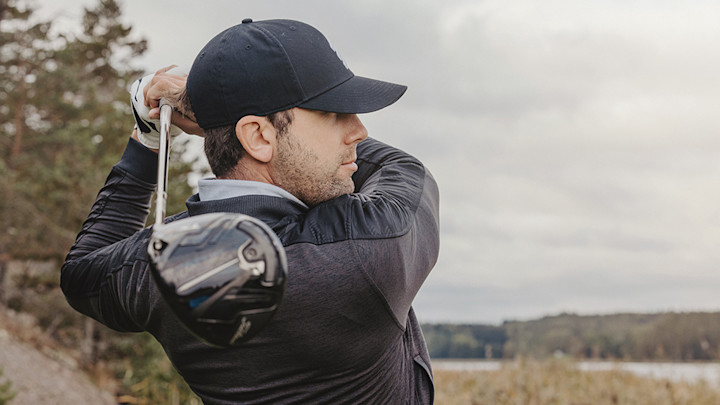
14 expert tips for a better driver purchase
Most of us dream about hitting it longer. That’s why shopping for a driver is so much fun. But before you come and visit us, there’s plenty to think about for the serious buyer. Here are 14 good questions to ask, according to Dormy’s experts Magnus Svahlin, Nicklas Holmander and Axel Engelberth.
1. What kind of driver player are you today?
Do you have a typical miss? Does the ball always curve the same way, or are you one of the few who consistently finds the fairway? Make a mini-analysis of your tee shots and be honest with yourself. The better you understand your own game, the easier it is to help you.
2. What are your preferences regarding feel and looks?
Everyone likes different things. An important part of finding the right driver is that you enjoy looking at it. That builds confidence before the shot and often allows you to swing more freely and naturally. Feel is subjective – but what feel do you want from a driver?
3. Do you want to test the club in real conditions?
At Dormy, we have most drivers as demo clubs. This means you can borrow them and take them out on the course to try them. How does the club feel under pressure – when you need to hit a narrow fairway or bomb the ball down a long par 5? Test it for 24 hours to get a better sense before making your driver purchase!
4. What do you want to achieve with a new driver?
Many say they want to hit longer and straighter. But achieving that often requires practice. A driver can, however, be a big help in eliminating an unwanted slice or creating a feel – which in turn can lead to both distance and accuracy. Think about whether there’s something specific you want to accomplish.
5. What sound do you like?
What really defines “feel” in a driver? Often, it’s the sound – the confirmation of a solid strike. Many manufacturers differ significantly in this aspect. What do you want to hear? A deeper thud, or a slightly higher ping with more zing?

6. What is your price range?
A driver can cost anywhere from 2,500 to 7,500 SEK, depending on model year, brand, and specification. A driver might seem like a driver, but there are differences that can show in various ways. The best chance of finding the perfect driver is to look at newer models, where we have full fitting options and can adjust everything from shaft to grip. Older models have fewer customization options, but you can still find great alternatives, even if the technology isn’t the newest.
7. Is your swing or game changing?
Some work hard to improve their golf game, while others may lose a bit of ability with age. Many parameters affect what type of driver you should have. The more honest you are with yourself, the better the outcome. Maybe you’re working toward a specific goal with your coach, or perhaps your physical condition has changed since you bought your last driver.
8. What is your ambition level versus reality?
Never be shy about telling the fitter what you want. If you want a driver that hits 20% more fairways without three hours of weekly practice, say so. If you want maximum distance, say that too – even if it means a few range buckets to control dispersion. Give an honest picture of your goals and how much time you’re willing to put in – it makes the fitting process easier.
9. Is the new driver better?
If you take a demo club out on the course, you can always compare it with your old one. We also recommend bringing your current driver to your fitting to see the actual differences. At our test centers, Trackman shows data “black on white” to make it as fair as possible. In some cases, the result may be that we recommend keeping your old driver because it performs better – even if that sounds a bit disappointing.

10. Do you dare to refuse the macho style?
Many golfers need a lighter, more flexible shaft than they currently play with! Some think that if they hit a fade or slice, the shaft is too soft because friends say they swing fast. That’s often not the case – it’s usually a swing-technical issue. Low-handicap golfers sometimes play shafts that are technically too stiff just to show off Stiff or X-Stiff. Sure, some mishits improve slightly with a stiffer shaft, but your pursuit of optimal distance is sacrificed, and you’ll quickly find yourself looking for a new driver. A good general tip is to drop the macho approach and choose a softer shaft.
11. Do you need to adjust the characteristics?
Most golfers get help from us to set up their driver and then play with it consistently. But a few like to experiment with the settings. There’s nothing wrong with that, as long as you understand how it affects the ball flight. Most drivers today are adjustable, though to varying degrees. How important is that to you?
12. How do you want the ball to get to its final spot?
Manufacturers today have rules to follow regarding club characteristics, which makes revolutionary innovations difficult. Yet the latest models often go a few meters further than their predecessors. This is because ball flight is more optimized through height and spin. Loft is therefore incredibly important. Many golfers today say they hit too high and that the ball doesn’t roll as far as their friend’s. So the question is whether we’re looking for carry distance or total distance. How do you want your ball flight to look, and what should the final result be?

13. How do you want the shaft to feel?
This can be advanced for some, who just want the shaft to feel “good.” But with different shaft characteristics, you can change both security off the tee and the feel of the swing. Can you put into words what you are looking for? A feeling that the club swings easily, or maybe that it doesn’t twist in your hands on off-center hits. These are factors that influence shaft choice.
14. Do you dare to buy without a fitting?
The simple answer is, of course, you shouldn’t. At Dormy, the cost is deducted from the purchase price, so it makes no sense not to take advantage of this. At the test center, you get the luxury of a knowledgeable expert’s full attention to find the best option for you. It’s also a fun and educational experience.
15. Can you afford to buy the wrong driver?
Prices usually range from 3,000 to 7,000 SEK, and whether that’s cheap or expensive is subjective. But one thing we can agree on: buying the wrong driver is costly! So make sure to use all the expertise our staff has. They are always fully updated on what the latest models can do for your golf.
